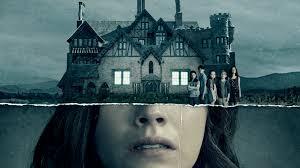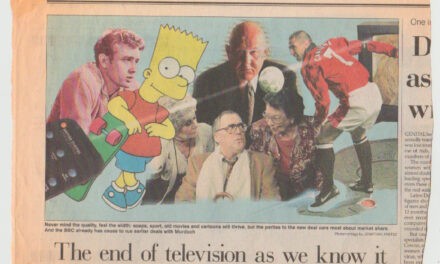This blog post has been sparked by the exorbitant amount of video recommendations that YouTube has offered up to me during the last few weeks after I finished season 2 of The Bear (Hulu, 2022—). In these various video essays (see list below), content creators talk about why The Bear is such a ‘perfect’ show or why certain episodes of The Bear are ‘perfect’ episodes. Video titles include ‘Why The Bear Season 2 Episode 10 Is So Important’ by BrainPilot, and the voiceover in this video starts with: ‘Yep, another Bear video. But the show is too good not to talk about, so that’s my defence’ (2023). Indeed, online discourse about The Bear in articles and YouTube videos emphasizes its status as ‘quality TV’ through the use of terms such as perfection, efficiency, but also its ability to elicit affective and emotional responses from viewers. Regarding the latter, there is too much to unpack for this blog post (starting with ongoing debates about what constitutes and differentiates affects and emotions), but The Bear’s melodramatic elements, especially in the oft-discussed ‘Fishes’, as well as the characters’ ‘socioemotional’ dimensions (see Pribram, 2018) certainly warrant further scholarly exploration. For now, I will focus on engaging with a few takeaways from watching video essay after video essay about The Bear that are about the medium of television’s affordances concerning aesthetics, narrative time, and evaluation.
As Hollis Griffin points out, with reference to Jason Mittell (2015), Charlotte Brunsdon (1990), Christine Geraghty (2003), and Stephen Peacock and Jason Jones (2013), “aesthetic evaluation has long been a topic of debate among television scholars” (2017, 74), underlining its importance as scholars otherwise “forgo opportunities to potentially transform” (74) the medium of television. I would, therefore, like to take a closer look at a few of the evaluations proposed in the many video essays that exist about The Bear’s perfection as a television programme. The extent to which the video essays YouTube has been recommending to me analyse and evaluate The Bear varies, of course, with some of them going into thoughtful detail regarding the programme’s use of narrative devices and its aesthetic components. All of these video essays contain numerous evaluations as video essayists engage in close readings of individual scenes, entire episodes, character arcs, as well as The Bear’s atmosphere. For example, in ‘The Bear: Analyzing the Subtlety of Marcus’, atmosphere is used to describe the contrast between an episode like ‘Honeydew’ with other, more fast-paced and stressful episodes. The programme’s oscillation between chaotic stress and calm pensiveness in season two is mentioned frequently as something that makes for efficient storytelling. Video essayists keep pointing out that The Bear’s chaos is deliberate and well-engineered, such as in ‘Review’, an episode that, after its initial two-and-a-half minutes, consists of one single shot without cuts or editing. In season two, main characters Carmy and Sid, in a self-referential comment that is as much about The Bear as a narrative as it is about their budding restaurant’s menu, aptly call their vision for The Bear (formerly The Beef) ‘thoughtful chaos’.
In a video titled ‘The Bear Season 2: Thoughtful Chaos’, J.R.R. Talkin breaks down some of season two’s storytelling techniques in order to illustrate their claim that The Bear is ‘decisively the best short-form comedy-drama we’ve had in a long time’ that goes ‘from constant anxiety to deep introspection all while maintaining its trademark tension’ through ‘a well-organized delivery of classic storytelling maneuvers and literally ancient human purpose’ (from the video description on YouTube, 2023).
One of this video’s observations is that The Bear offers ‘a stunning mix of cinematography where every frame is lovely to look at but also communicates a feeling that fits each moment perfectly—the lighting, the blocking, the pacing, the accuracy to the industry and Chicago—but at the end of the day, The Bear is able to do what it does […] thanks to immaculately organised storytelling’ (2023). The video essay then analyses three episodes in season two in detail, arguing that they stand out because they represent breaks in the overall narrative arc as they either focus on secondary characters (‘Honeydew’ and ‘Forks’) or delve into the past (‘Fishes’).
The way The Bear places individual episodes as units or chapters in each season indeed accentuates its oscillation between the thoughtful, but certainly very stressful, chaos and heightened anxiety and pressure in some episodes on the one hand, and the calmness, reflection in other episodes. As I have mentioned briefly above, video essayists point this out in particular with respect to season two, in which entire episodes act as what Kristyn Gorton calls resilient pauses in an analysis of The Handmaid’s Tale and what Sue Thornham calls breathing spaces when she discusses Happy Valley and Mare of Easttown. In The Bear’s, these episodes are ‘Honeydew’ and ‘Forks’. The entire episodes feel like pauses during which characters get to take a breath and a break from the chaos alongside the audience. These episodes only start ‘appearing’ in the programme’s second season, which is comprised of 10 episodes, in contrast to season one’s eight episodes. The parameters of the programme’s story time (characters, especially secondary characters, get to take breaks to develop as cooks—and, more importantly—as characters as the restaurant space of the former Beef is being remodelled before the opening of The Bear), as well as the discourse time (when we add up the running time of all of season two’s episodes, we get almost six hours, in contrast to season one’s just a little over four hours) align in season two in this way. Slower, calmer scenes are more frequent within all of season two’s episodes and offer resilient pauses or breathing spaces in ‘Fishes’, which inserts a few tender exchanges between characters into the chaotic and melodramatic Berzatto family Christmas dinner. The placement of the episode is, to use a word frequently employed in various video essays about The Bear, very effective in building character alignment, as it is a flashback to five years ago, in the middle of the second season, when viewers have already gotten to know and care about the show’s characters. The Bear’s episode lengths vary in a few instances, and although other programmes, such as Stranger Things (Netflix, 2016—), have done this, what these variations do is discussed frequently in video essays about The Bear. The contrast between most episodes, which are about a half-hour in length (see a list of all episode lengths below), and episodes like ‘Review’ (20 minutes, with almost the entirety of the episode filmed in one take) or ‘Fishes’ (an hour-long flash-back and examination of the Berzatto family that is, interestingly, framed as a memory by Carmy in a conversation in a subsequent episode when he mentions, in passing, that he was just telling his girlfriend about the incident viewers have just witnessed at the end of ‘Fishes’) is noticeable and, in each case, part and parcel of the affectivity of these episodes.
The many video essays that discuss The Bear as a ‘perfect’ television programme, as well as my own fascination with the show’s ‘thoughtful chaos’, and conversations I have had with television scholars and friends who have watched and evaluated The Bear as an ‘excellent’ piece of TV raise many of the questions that have been at the heart of television studies for a long time, including those that revolve around what constitutes ‘quality’ in the first place and how a programme’s affective dimensions ‘reach’ or ‘touch’ us through its aesthetics and storytelling devices. As I have now devoured both seasons of The Bear multiple times and I am running out of video essays to consume on YouTube, I am starting to crave scholarly attention to The Bear’s ‘perfect’ storytelling recipe.
Sarah Lahm is a postgraduate researcher at the School of Media and Communication at the University of Leeds. Her research is concerned with complex female characters in contemporary US TV, as well as the aesthetics and storytelling practices of twenty-first century ‘quality TV’. She is currently writing up her PhD thesis on ambivalence and female subjectivity in recent women-centric half-hour dramas, in which she investigates articulations of the contradictions of current feminist discourse and the trope of the fragmented or split self.
References
Brunsdon C (1990) Television: Aesthetics and Audiences. In: Mellencamp L ed. Logics of Television: Essays in Cultural Criticism. Bloomington: Indiana University Press, 59-70.
Geraghty C (2003) Aesthetics and Quality in Popular Television Drama. International Journal of Cultural Studies 6(1), 25-45. DOI: 10.1177/1367877903006001002
Gorton K (2021) ‘Don’t Let the Bastards Grind You Down’: Feminist Resilience/Resilient Feminism in The Handmaid’s Tale (Hulu, 2017—). Critical Studies in Television 16(3), 227-244. DOI: 10.1177/17496020211021326
Griffin H (2017) Evaluating Television: Affect as a Critical Optic. Cinema Journal 57(1), 71-93. https://jstor.org/stable/44867859
Mittell J (2015) Complex TV: The Poetics of Contemporary Television Storytelling. New York: NYU Press.
Peacock S and Jones J eds. (2013) Television Aesthetics and Style. New York: Bloomsbury.
Pribram E D (2018) Melodrama and the Aesthetics of Emotion. In: Gledhill C and Williams L eds. Melodrama Unbound: Across History, Media, and National Cultures. New York: Columbia University Press, 237-251.
Thornham S (2022) Breathing Spaces? The Politics of Embodiment, Affect, and Genre in Mare of Easttown and Happy Valley. Feminist Media Studies, DOI: 10.1080/14680777.2022.2047091.
Video essays analysing and evaluating The Bear on YouTube
- Why THE BEAR Season 2 Episode 10 Is SO Important, BrainPilot, 2023, https://youtube.com/watch?v=4ncU-d6JcwY
- FX’s The Bear is Surprisingly Worth Your Time, Critical Crackpot, 2022, https://youtube.com/watch?v=fyiSZHGYTWg
- Understanding The Bear’s Richie: Fear, Change and Redemption, Valaritas, 2023, https://youtube.com/watch?v=8bzE1Vj8gIU
- A Look Inside the Mind of Richie in The Bear Season 2, BrainPilot, 2023, https://youtube.com/watch?v=eyJ7Qt6Myec
- The Bear: Analyzing the Subtlety of Marcus, HupahZ, 2023, https://youtube.com/watch?v=C5sRDy0EvMU
- A Look Inside the Mind of Carmy in The Bear Season 2, BrainPilot, 2023, https://youtube.com/watch?v=5_htIvxQ_Lg
- The Bear Season 2 Did Something Different, Subtly, Valaritas, 2023, https://youtube.com/watch?v=ISCk-b7Vw3M
- The Bear’s Season 2 Episode 6 Is A Masterclass on Generational Trauma, Valaritas, 2023, https://youtube.com/watch?v=iDozzVkpQMQ
- FX’s The Bear Season 2 Is Breathtakingly Beautiful, Critical Crackpot, 2023, https://youtube.com/watch?v=61ekR1YslWc
- The Bear Season 2: Thoughtful Chaos, J.R.R. Talkin’, 2023, https://youtube.com/watch?v=q8DhRpPLJV4
- The Bear Season 2 is Peak TV—Review, Jack the Boss, 2023, https://youtube.com/watch?v=y4u6V3z2UM8
- The Bear Season 2 Is Incredible | Review, Austin Burke, 2023, https://youtube.com/watch?v=0UGtodlKyK8
- This One Addition Fixed The Bear, Entertain the Elk, 2023, https://youtube.com/watch?v=N22_d067R-Y
- Why The Bear Season 2 Episode 6 Is Perfect, BrainPilot, 2023, https://youtube.com/watch?v=S8GfQRK9D3o&t=27s
- Why The Bear Season 2 Episode 7 Is Perfect, BrainPilot, 2023, https://youtube.com/watch?v=2Enn5BlNLqA
- Why The Bear Season 2 Episode 4 is Perfect, BrainPilot, 2023, https://youtube.com/watch?v=fz45mctx6M8
- The Bear Season 2 Ending Explained, BrainPilot, 2023, https://youtube.com/watch?v=q6ng64koz30
The Bear‘s Episode Lengths at a glance
Season 1
- 1.1. ‘System’: 28m
- 1.2 ‘Hands’: 32m
- 1.3 ‘Brigade’: 30m
- 1.4 ‘Dogs’: 31m
- 1.5 ‘Sheridan’: 25m
- 1.6 ‘Ceres’: 30m
- 1.7 ‘Review’: 20m
- 1.8 ‘Braciole’: 48m
Season 2
- 2.1 ‘Beef’: 29m
- 2.2 ‘Pasta’: 30m
- 2.3 ‘Sundae’: 26m
- 2.4 ‘Honeydew’: 29m
- 2.5 ‘Pop’: 33m
- 2.6 ‘Fishes’: 1h 6m
- 2.7 ‘Forks’: 35m
- 2.8 ‘Bolognese’: 32m
- 2.9 ‘Omelette’: 38m
- 2.10 ‘The Bear’: 40m





